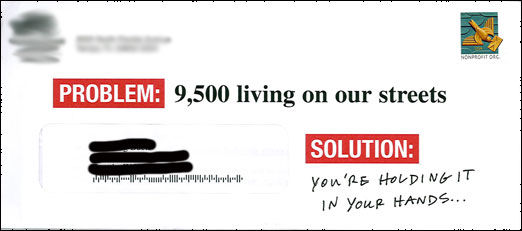The teaser on your outer envelope is far more important than most nonprofits realize.
To help you write better teasers – which will help you raise more money – here are three simple tips for you.
Most successful teasers fall into three categories:
- Dramatic. These are teasers that use drama to pique the reader’s interest in order to get her to open the envelope. Some examples: “The Arts are shutting down” and “He used to run a company, now he’s on the streets” and “desperate.”
- Mysterious. These are teasers that use mystery to make the reader wonder what’s inside, in order to get her to open the envelope. Some examples: “The light came on” and “Enclosed: note from a child.” Note that not having a teaser – using a blank outer envelope – falls into this category.
- Multiplier. These are teasers that appeal to the donor’s sense of value and thriftiness in order to get her to open the envelope. Some examples: “Your gift DOUBLES” and “$1 = $5!”
The best teasers often have elements of more than one category. You see this at work in a teaser like “3x” – which has both mystery and a multiplier.
The Big Idea
Notice something in all of those descriptions above: all the teasers exist to get the donor to open the envelope.
That’s it. That’s the purpose of a teaser: to give the donor a compelling reason to open the envelope.
The whole purpose of any ink used on the envelope should be to increase the chances that a donor will open the envelope.
That’s why, for instance, I always counsel organizations to remove their URL and social info from their outer envelope. You just paid money to write, design, print and send a letter to a person – and so you put your website address on the envelope so that the person has a smaller chance of reading the letter?!? It doesn’t make sense.
The envelope exists to 1) carry the letter and 2) to get people to open it.
Watch Out For…
Watch out for teasers that basically say, “You’re going to be asked for money; inside!”
Those usually reduce response unless they are accompanied by one of the three ideas above.
Quick Story
I was reminded of these when reading a book on direct response marketing. It told a brief story.
An organization had a successful direct mail pack as their control. They ran a test where everything about the pack was exactly the same, except the teaser.
The new teaser was: “Deeply and irrevocably personal.”
A little weird, right?
That teaser increased response to the package by 20%!
That shows the power of a good teaser.
So spend a bit more time on yours – you can see immediate increases in your fundraising!
Steven Screen is Co-Founder of The Better Fundraising Company and lead author of its blog. With over 30 years' fundraising experience, he gets energized by helping organizations understand how they can raise more money. He’s a second-generation fundraiser, a past winner of the Direct Mail Package of the Year, and data-driven.









What’s wrong with a leading prompt that indicates a solicitation is inside if there’s fear no one opens the envelope? Then at least you get the ask out right?
Hi Amy! All I can tell you is that, from looking at the results of thousands of direct mail packages, revenue usually goes down when there’s a leading prompt that there’s a solicitation inside. Here’s my super-short summary for why that is: when the teaser just implies that a solicitation is inside, fewer people open the envelope. Teasers that are interesting, dramatic, mysterious, or mention a multiplier, all give donors more reasons to open the envelope, and those types of teasers tend to result in more money being raised. I should mention that there is at least one exception: “annual fund” is an effective teaser in some cases.